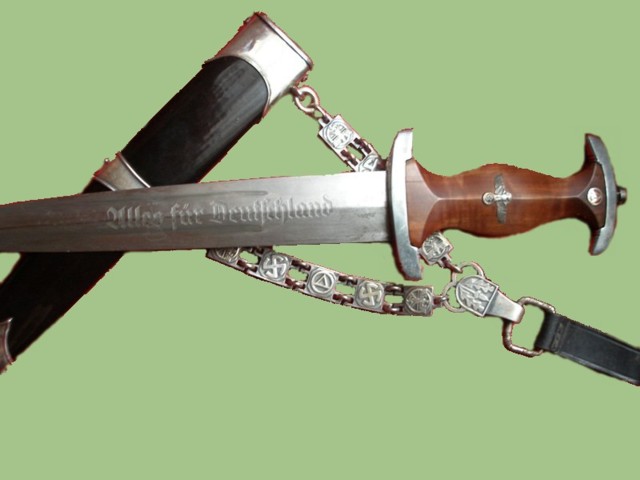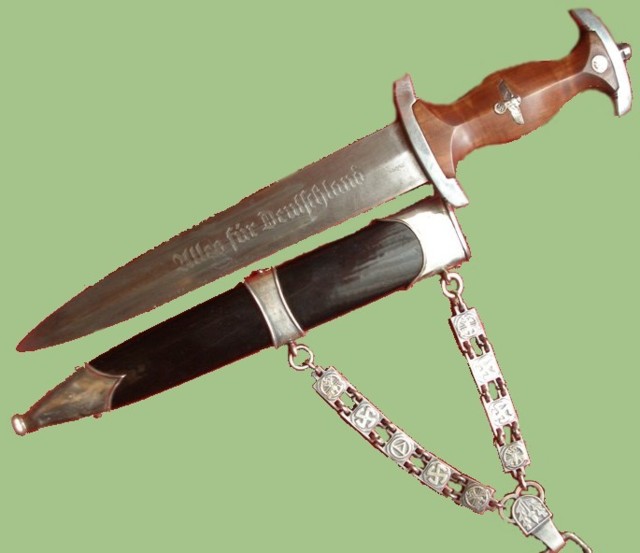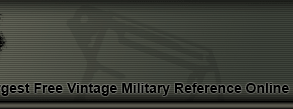WWII German 1938 NSKK Fuhrer Chained Dagger -
The National Socialist Motor Corps (German: Nationalsozialistisches Kraftfahrkorps, NSKK), also known as the National Socialist Drivers Corps, was a paramilitary organization of the Nazi Party that existed from 1931 to 1945. The group was a successor organization to the older National Socialist Automobile Corps, which had existed since the beginning of 1930. It was headed by Adolf Hühnlein from 1934. After Hühnlein's death in 1942 Erwin Krauss took over his position as Korpsführer (Corpleader).
The National Socialist Motor Corps was the smallest of the Nazi Party organizations and had originally been formed as a motorized corps of the Sturmabteilung (SA). In 1934, the group had a membership of approximately ten thousand and was separated from the SA to become an independent organization. This action may have saved the NSKK from extinction, as shortly thereafter the SA suffered a major purge during the Night of the Long Knives.
The Fuhrer NSKK dagger was instituted in January 1938. It was presneted to all of the NSKK Fuhrers. A
lower grade dagger was available.

The design of the dagger consists of s simple pommel. The handle is in the shape of a Coke bottle. It is made
of wood. It has the SA logo in the upper portion. The SA eagle is placed at about the center point of the handle.
The handguard matches the pommel piece.
The scabbard is made of metal. Painted black. It has three silver fittings. one at the throat section. One at
midpoint and the other at the tip. The throat and midpoint sections have loops where the chain attaches.

The blade is of stiletto design. Double edge. It has the motto "Alles Fur Deutchsland" on one side.
The other side is plain. The blade is not sharpened as it was never intended for fighting.
The chain has a total of nine links. Four on the throat section. Five in the mid section. The front of the links
alternate in patterns between an eagle holding a swastika, a swirled swastika and a triangle. The back of
the links are marked: Musterschutz NSKK Korpsfuhrung. Each link is secured via the use of two rings.
Both sets of links converge into a single piece with two rings at the bottom. An oakleaf in the center. The piece
connects to a spring loaded clip which attaches to a leather strap.

|
This page is a recognition and identification guide for German bayonets. Multiple
detailed photos of a specific sample are provided. Descriptions point out specific
points that should be noted.
One of the most commonly asked questions is "How much is my German bayonet worth?".
A price guide is included here to address this question. The value of the Nazi bayonets is
reviewed over a period of several years. A trend can be observed. The present worth
of the police sword in the collector's market is illustrated.
This service is provided free of charge to the visitor/enthusiast courtesy of
MilitaryItems.com,
a company dedicated
to the preservation of military history and to providing quality military antiques and
collectibles to museums, institutions and the general public.
|
|

Many German edge weapons are currently
reproduced.
It is becoming more difficult to be able to tell the fake ones from the real ones because
the quality of the reproductions is improving. The collector must become familiarized with
the construction style and materials employed in the manufacturing of this item.
Attention to the details is critical in order to be able to determine the authenticity of
the collectible.
If you have an interest is seeing other edge weapons of the Third Reich, you can do so by going
to our
WWII German daggers and Swords
identification guide, Where we cover blades from the Heer (Army), Navy (Kriegsmarine), Air Force
(Luftwaffe) and other organizations.
|







